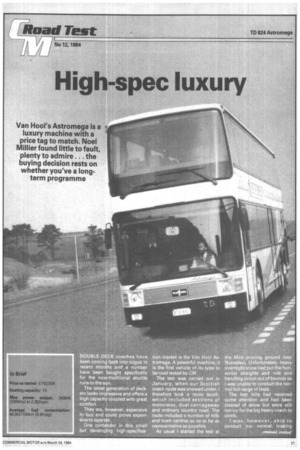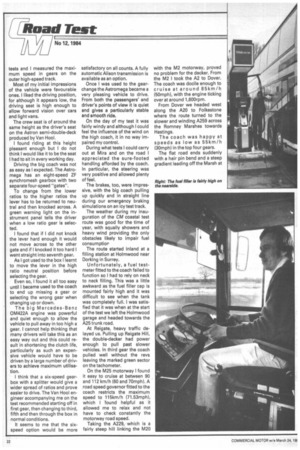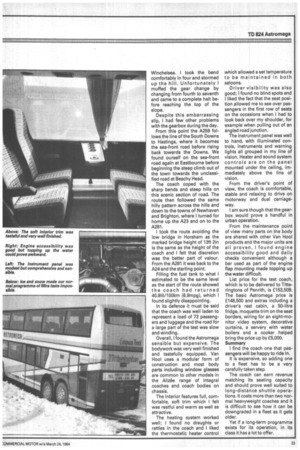DOUBLE-DECK coaches have been coming back into vogue in recent
Page 23

Page 24

Page 25

If you've noticed an error in this article please click here to report it so we can fix it.
months and a number have been bought specifically for the now-traditional shuttle runs to the sun,
The latest generation of deckers looks impressive and offers a high capacity coupled with great comfort.
They are, however, expensive to buy and could prove expensive to operate.
One contender in this small but developing high-specifica lion market is the Van Hoof Astromega. A powerful machine, it is the first vehicle of its type to be road tested by CM.
The test was carried out in January, when our Scottish coach route was snowed under. I therefore took a route south, which included sections of motorway, dual carriageway and ordinary country road. The route included a number of hills and town centres so as to be as representative as possible.
As usual I started the test at the Mira proving ground near Nuneaton. Unfortunately heavy overnight snow had put the horizontal straights and ride and handling circuit out of bounds so I was unable to conduct the normal full range of tests.
The test hills had received some attention and had been cleared of snow but were still too icy for the big heavy coach to climb.
I was, however, able to conduct our normal braking tests and I measured the maximum speed in gears on the outer high-speed track.
Most of my initial impressions of the vehicle were favourable ones. I liked the driving position, for although it appears low, the driving seat is high enough to allow forward vision over cars and light vans.
The crew seat is of around the same height as the driver's seat on the Astron semi-double-deck produced by Van Hod.
I found riding at this height pleasant enough but I do not think I would like it to be the seat I had to sit in every working day.
Driving the big coach was not as easy as I expected. The Astromega has an eight-speed ZF synchromesh gearbox with two separate four-speed "gates".
To change from the lower ratios to the higher ratios the lever has to be returned to neutral and then knocked across. A green warning light on the instrument panel tells the driver when a low ratio gear is selected.
I found that if I did not knock the lever hard enough it would not move across to the other gate and if I knocked it too hard I went straight into seventh gear.
As I got used to the box I learnt to move the lever in the high ratio neutral position before selecting the gear.
Even so, I found it all too easy until I became used to the coach to end up missing a gear or selecting the wrong gear when changing up or down.
The big Mercedes-Benz 0M422A engine was powerful and quiet enough to allow the vehicle to pull away in too high a gear. I cannot help thinking that many drivers will take this as an easy way out and this could result in shortening the clutch life, particularly as such an expensive vehicle would have to be driven by a large number of drivers to achieve maximum utilisation.
I think that a six-speed gearbox with a splitter would give a wider spread of ratios and prove easier to drive. The Van Hod l engineer accompanying me on the test recommended starting off in first gear, then changing to third, fifth and then through the box in normal conditions.
It seems to me that the sixspeed option would be more satisfactory on all counts. A fully automatic Alison transmission is available as an option.
Once I was used to the gearchange the Astromega became a very pleasing vehicle to drive. From both the passengers' and driver's points of view it is quiet and gives a particularly stable and smooth ride.
On the day of my test it was fairly windy and although I could feel the influence of the wind on the high coach, it in no way impaired my control.
During what tests I could carry out at Mira and on the road I appreciated the sure-footed handling afforded by the coach. In particular, the steering was very positive and allowed plenty of feel.
The brakes, too, were impressive, with the big coach pulling up quickly and in straight line during our emergency braking simulations on an icy test track.
The weather during my inauguration of the CM coastal test route was good for the time of year, with squally showers and heavy wind providing the only obstacles likely to impair fuel consumptior
The route started inland at a filling station at Holmwood near Dorking in Surrey.
Unfortunately, a fuel testmeter fitted to the coach failed to function so I had to rely on neck to neck filling. This was a little awkward as the fuel filler cap is mounted fairly high and it was difficult to see when the tank was completely full. I was satisfied that it was when at the start of the test we left the Holmwood garage and headed towards the A25 trunk road.
At Reigate, heavy traffic delayed us, Pulling up Reigate Hill, the double-decker had power enough to pull past slower vehicles. In third gear the coach pulled well without the revs leaving the marked green sector on the tachometer.
On the M25 motorway I found it easy to cruise at between 90 and 112 km/h (60 and 70mph). A road speed governor fitted to the coach restricts the maximum speed to 115km/h (71.53mph), which I 'found helpful as it allowed me to relax and not have to check constantly the motorway road speed.
Taking the A229, which is a fairly steep hill linking the M20 with the M2 motorway, proved no problem for the decker. From the M2 I took the A2 to Dover. The coach was docile enough to cruise at around 8 5 km/h (50mph), with the engine ticking over at around 1,600rpm.
From Dover we headed west along the A20 to Folkestone where the route turned to the slower and winding A259 across the Romney Marshes towards Hastings.
The coach was happy at speeds as low as 5 5km/h (30mph) in the top four gears.
The flat road ends suddenly with a hair pin bend and a steep gradient leading off the Marsh at Winchelsea. I took the bend comfortably in four and stormed up the hill. Unfortunately I muffed the gear change by changing from fourth to seventh and came to a complete halt before reaching the top of the slope.
Despite this embarrassing slip, I had few other problems with the gearbox during the day.
From this point the A259 follows the line of the South Downs to Hastings, where it becomes the sea-front road before rising back towards the Downs. We found ourself on the sea-front road again at Eastbourne before beginning the steep climb out of the town towards the unclassified road at Beachy Head.
The coach coped with the sharp bends and steep hills on this scenic section of road. The route then followed the same hilly pattern across the hills and down to the towns of Newhaven and Brighton, where I turned for home up the A23 and on to the A281.
I took the route avoiding the low bridge in Horsham as the marked bridge height of 13ft 2in is the same as the height of the coach and I felt that discretion was the better part of valour. From the A281 it was back to the A24 and the starting point.
Filling the fuel tank to what I estimated to be the same level as the start of the route showed the coach had returned 40.91it/100km (6.9mpg), which I found slightly disappointing.
In its defence it must be said that the coach was well laden to represent a load of 73 passengers and luggage and the road for a large part of the test was slow and winding.
Overall, I found the Astromega sensible but expensive. The bodywork was very well finished and tastefully equipped. Van Hool uses a modular form of construction and most body parts including window glasses are common to other models in the Alithe range of integral coaches and coach bodies on chassis.
The interior features full, comfortable, soft trim which I felt was restful and warm as well as attractive.
The heating system worked well; I found no draughts or rattles in the coach and I liked the thermostatic heater control which allowed a set temperature to be maintained in both saloons.
Driver visibility was also good; I found no blind spots and 1 liked the fact that the seat position allowed me to see over passengers in the first row of seats on the occasions when I had to look back over my shoulder, for example when pulling out of an angled road junction.
The instrument panel was well to hand, with illuminated controls, instruments and warning lights all grouped in my line of vision. Heater and sound system controls are on the panel mounted under the ceiling, immediately above the line of vision.
From the driver's point of view, the coach is comfortable, stable and relaxing to drive on motorway and dual carriageway.
I am sure though that the gearbox would prove a handful in urban operation.
From the maintenance point of view many parts on the body are shared with other Van Hodl products and the major units are all proven. I found engine accessibility good and daily checks convenient although a bar used as part of the engine flap mounting made topping up the water difficult.
List price for the test coach, which is to be delivered to Titteringtons of Penrith, is £153,509. The basic Astromega price is £148,500 and extras including a driver's rest cabin, a 50-litre fridge, moquette trim on the seat borders, wiring for an eight-monitor video system, decorative curtains, a servery with water boilers and a cooker helped bring the price up by £5,000. Summary
I find the coach one that passengers will be happy to ride in.
It is expensive, so adding one to a fleet has to be a very carefully taken step.
The coach can earn revenue matching its seating capacity and should prove well suited to long-distance shuttle operations. It costs more than two normal heavyweight coaches and it is difficult to see how it can be downgraded in a fleet as it gets older.
Yet if a long-term programme exists for its operation, in its class it has a lot to offer.
























































































